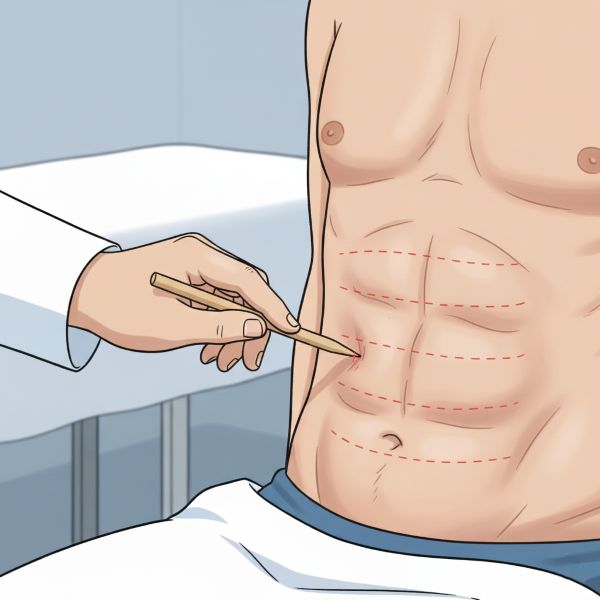Abdominal Reflexes
Abdominal Reflexes
Both superficial and deep abdominal reflexes are described, of which the superficial (cutaneous) reflexes are the more commonly tested in clinical practice. These reflexes involve the contraction of the abdominal muscles in response to a tactile stimulus.
Technique
A wooden stick or pin is used to scratch the abdominal wall, from the flank to the midline, parallel to the line of the dermatomal strips, in upper (supraumbilical), middle (umbilical), and lower (infraumbilical) areas. The maneuver is best performed at the end of expiration when the abdominal muscles are relaxed, since the reflexes may be lost with muscle tensing. To avoid this, patients should lie supine with their arms by their sides.

Testing the superficial abdominal reflexes by stroking the skin from the flank towards the midline.
Interpretation of Absent Reflexes
Superficial abdominal reflexes may be lost due to physiological or benign reasons, including:
- Normal aging
- Obesity
- Previous abdominal surgery
- After multiple pregnancies
- In acute abdominal disorders (Rosenbach’s sign)
Clinical Significance
The absence of superficial abdominal reflexes can have significant localizing value. Unilateral absence of the reflexes can indicate corticospinal pathway damage (an upper motor neurone lesion) on the same side. The specific reflexes that are absent can help pinpoint the level of the lesion:
- Absence of all superficial abdominal reflexes may suggest a lesion above the T6 spinal level.
- Lesions at or below T10 can cause a selective loss of the lower reflexes while the upper and middle reflexes remain intact. In this scenario, Beevor’s sign may also be present.
- Lesions below T12 typically spare all abdominal reflexes.
Abdominal reflexes are often noted to be lost early in the course of multiple sclerosis but are typically preserved until late in motor neurone disease. This distinction can be clinically useful, particularly when differentiating the primary lateral sclerosis variant of motor neurone disease from multiple sclerosis, although prospective studies have not definitively confirmed this observation.
References
Dick JPR. The deep tendon and the abdominal reflexes. Journal of Neurology, Neurosurgery and Psychiatry 2003; 74: 150-153
Cross References
Beevor’s sign; Upper motor neurone (UMN) syndrome

